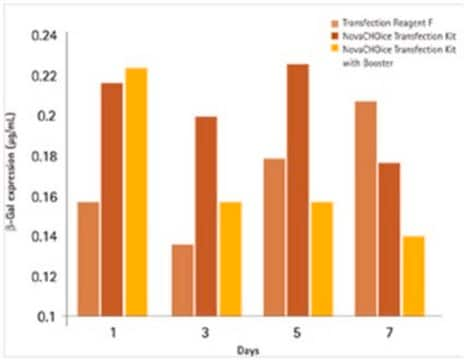CAPHOS
Calciumphosphat-Transfektionskit
Most cost effective transfection reagent kit for transient and stable transfection of DNA into mammalian cells
Synonym(e):
Gene delivery
About This Item
Empfohlene Produkte
Qualität
for molecular biology
Qualitätsniveau
Form
solution
Verwendung
kit sufficient for 160 transfections (6 cm dishes)
kit sufficient for 400 transfections (3.5 cm dishes)
kit sufficient for 80 transfections (10 cm dishes)
Methode(n)
transfection: suitable
Versandbedingung
dry ice
Lagertemp.
−20°C
Verwandte Kategorien
Allgemeine Beschreibung
Anwendung
- für Transfektionsverfahren
- für die Transfektion von Hek293T-Zellen
- für die Transfektion von H29D-Zellen
BAEC
Melanomzellen des Darms
CHO K1
COS-7
Fibroblasten (human embryonal, Neo Derm)
HEK293
Huh 7
IMR-90
LLC (Lewis-Lungenkarzinom)
NIH3T3
PC-12
PCI-13
SH-Sy5Y
SK-Hep-1
T47D
Leistungsmerkmale und Vorteile
- Geeignet für transiente wie für stabile Transfektionen
- Reproduzierbar für eine breite Palette von Zellarten
- Häufig referenziert
- Kostengünstig
Komponenten
5 ml 2,5 M CaCl2 (C2052)
25 ml 2x HEPES-gepufferte Kochsalzlösung (H1012)
25 ml Wasser in Molekularbiologie-Qualität (W4502)
Prinzip
Sonstige Hinweise
Ähnliches Produkt
Signalwort
Warning
H-Sätze
Gefahreneinstufungen
Eye Irrit. 2
Lagerklassenschlüssel
12 - Non Combustible Liquids
Flammpunkt (°F)
Not applicable
Flammpunkt (°C)
Not applicable
Analysenzertifikate (COA)
Suchen Sie nach Analysenzertifikate (COA), indem Sie die Lot-/Chargennummer des Produkts eingeben. Lot- und Chargennummern sind auf dem Produktetikett hinter den Wörtern ‘Lot’ oder ‘Batch’ (Lot oder Charge) zu finden.
Besitzen Sie dieses Produkt bereits?
In der Dokumentenbibliothek finden Sie die Dokumentation zu den Produkten, die Sie kürzlich erworben haben.
Kunden haben sich ebenfalls angesehen
Artikel
Transfection introduces genetic material into cells, aiding research in gene expression and cell biology.
This brief webinar provides an overview of what transfection is and the methods that are used to introduce DNA or RNA into eukaryotic cells.
Protokolle
Calcium phosphate transfection is a common method for the introduction of DNA into eukaryotic cells. This protocol can be optimized for use with a wide variety of cell types.
Verwandter Inhalt
Browse our convenient transfection reagent selection guide to match the best reagent for your specific cell line and application needs.
Unser Team von Wissenschaftlern verfügt über Erfahrung in allen Forschungsbereichen einschließlich Life Science, Materialwissenschaften, chemischer Synthese, Chromatographie, Analytik und vielen mehr..
Setzen Sie sich mit dem technischen Dienst in Verbindung.













